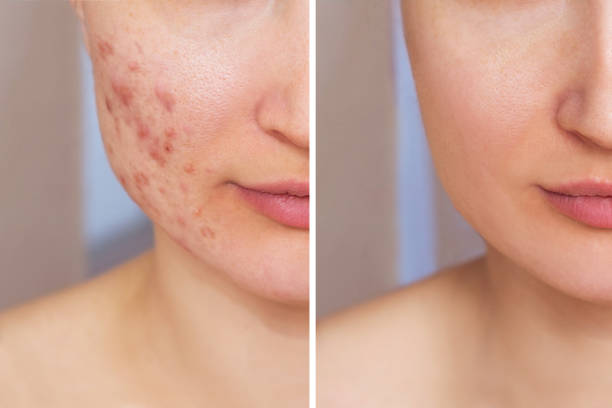Drugs and Medications
Dermatologists’ Best-Kept Secret Revealed: The Clindamycin Breakthrough
Introducing the best-kept secret among dermatologists: clindamycin, the skin savior. It looks that acne, a common person’s worst enemy, may have an opponent. Meet Clindamycin, the ground-breaking topical treatment that is taking the skincare industry by storm. Find out why this dermatologist favorite is the most sought-after treatment for a range of skin issues.
Understanding Clindamycin: What is it and how does it work?
Clindamycin is a potent topical antibiotic that is a member of the lincosamide drug family. It functions by preventing the growth of Propionibacterium acnes, a kind of bacteria that causes acne, on the skin. This particular bacteria is well known for generating inflammation and resulting in the development of acne lesions. Clindamycin efficiently reduces acne outbreaks and promotes cleaner skin by penetrating the skin’s oil glands and targeting and eliminating germs.
Clindamycin is a useful tool in the treatment of acne and other skin disorders because of its method of action. Its powerful capacity to fight inflammation and bacterial overgrowth distinguishes it as an effective remedy for a range of dermatological issues. Clindamycin, when taken as prescribed, may greatly enhance the general look and condition of the skin.

The Benefits of Clindamycin for Skincare
Clindamycin is a popular and adaptable therapy choice for people with acne and other skin conditions because of its many skincare advantages. Clindamycin’s capacity to lessen related inflammation and the quantity of acne lesions is one of its main benefits. The texture and general look of the skin are thus clearly improved.
How to Use Clindamycin for Acne Treatment
Clindamycin also helps to stop fresh acne outbreaks from forming, which is essential for preserving long-term skin clarity. Its anti-inflammatory qualities are also essential in reducing acne-related redness and pain and encouraging a more tranquil and balanced complexion. Clindamycin is also well-known for its ability to effectively cure deep-seated, obstinate acne that may not respond to conventional therapies.
For best results, compliance to the recommended parameters is crucial while using Clindamycin in an acne treatment plan. Clindamycin is usually offered in a number of forms, such as gels, creams, and solutions. Clindamycin must be taken regularly and according to prescription, even if results take time to show. To fully benefit from Clindamycin, persistence and following the prescribed course of action are essential. Additionally, as Clindamycin may make the skin more sensitive to sunlight, it is essential to protect the skin from the sun by wearing sunscreen and avoiding prolonged sun exposure.
- Cleanse Your Face: To get rid of any debris, oil, or makeup, start with a mild cleanser. Dry your skin using a fresh towel.
- Apply a Thin Layer: Treat the afflicted regions of your skin with a thin coating of Clindamycin, whether it’s a gel or lotion. Make sure you evenly cover the whole region prone to acne.
- Use Clean Hands: To stop bacteria from spreading, properly wash your hands both before and after using clindamycin.
- Avoid Eyes and Mouth: Take care not to apply Clindamycin in close proximity to your lips, nose, or eyes. If contact happens by mistake, give the area a thorough water rinse.
- Follow Your Dermatologist’s Instructions: Clindamycin should be taken as prescribed by your dermatologist, usually once or twice a day. Regarding how long to use it for and any other particular advice, heed their directions.
- Consistency is Key: Continue the treatment until your dermatologist gives you the all clear, even if you start to see improvements.
- Combine with a Gentle Skincare Routine: To enhance the benefits of clindamycin, use a gentle skincare regimen that consists of a non-comedogenic moisturizer and mild cleanser.
Potential Side Effects and Precautions
Clindamycin, like any medicine, may have some adverse effects, therefore it’s important to take measures. Dryness, peeling, or irritation at the application site are common adverse effects. People occasionally may suffer burning or itching, which, if severe or prolonged, should be reported to a healthcare professional.
Before taking Clindamycin, it is essential to speak with a dermatologist, particularly for those who have a history of allergies or skin sensitivities. For the safe and efficient use of Clindamycin, it is also necessary to report any current medical problems and prescription drugs. Potential side effects can be reduced by following the recommended dosage and seeing a healthcare provider right away if you have any concerns.
Clindamycin Products
There are several Clindamycin products on the market that satisfy a range of skincare requirements and preferences, all of which are approved by dermatologists. Clindamycin is frequently used with complimentary substances in these products to improve overall skin health and efficacy. There are several formulations of Clindamycin gels, creams, and foams that are designed to target different levels of acne severity.
Clindamycin products, which are recommended by dermatologists, are designed to provide the active component efficiently and to be compatible with various skin types. Getting expert advice from a dermatologist when choosing a Clindamycin product can help determine the best choice depending on specific skin issues and treatment objectives.
The Science Behind Clindamycin’s Effectiveness
Clindamycin’s focused antibacterial activity and anti-inflammatory effects are the main reasons for its success in treating acne and associated skin problems. Clindamycin helps treat the underlying causes of acne outbreaks by lowering inflammation and inhibiting the growth of germs that cause acne.
Clindamycin’s effectiveness in preventing new acne lesions is further enhanced by its capacity to pierce the skin’s sebaceous glands and limit bacterial development within the follicles. Clindamycin’s diverse method of treating acne makes it an effective ally in the pursuit of better, clearer skin. Clindamycin is a major topical therapy in dermatology, and its relevance is highlighted by the scientific knowledge of its actions.

Expert Tips for Incorporating Clindamycin into Your Skincare Routine
For greatest results, including clindamycin into a skincare regimen necessitates careful thinking and commitment to recommended methods. To keep skin balanced and hydrated, dermatologists frequently advise using Clindamycin in combination with mild, non-comedogenic cleansers and moisturizers. Clindamycin’s advantages are maximized while any dryness or irritation is reduced thanks to this synergistic strategy.
Clindamycin should also be used in conjunction with sun protection measures, such as using sunscreen with a high SPF, to protect the skin from UV ray damage. Clindamycin can be optimally included into a thorough skincare program by seeking the guidance and treatment suggestions of a dermatologist.
Clindamycin vs. Other Acne Treatments
Clindamycin’s distinct mode of action and suitability for various skin types must be taken into account when comparing it to other acne therapies. Clindamycin’s localized application decreases systemic exposure, which makes it a good alternative for people seeking focused acne care. This is in contrast to other oral drugs that may have systemic negative effects.
Furthermore, Clindamycin’s ability to work in conjunction with other topical therapies and its compatibility with other medications highlight how versatile it is in treating different levels of acne severity. As a key competitor in the acne therapy market, Clindamycin targets both the bacterial and inflammatory aspects of acne, providing a holistic strategy to controlling the condition.
Clindamycin: Myths vs. Facts
Despite all of the hype around clindamycin, it’s important to bust some common myths and misconceptions so that people may have a clear knowledge of how it works in skincare. A common misconception is that Clindamycin produces benefits right away. In fact, though, sustained and patient adherence to the treatment regimen is essential to seeing noticeable improvements over time.
Another myth is that Clindamycin can only be used to treat severe acne; it can also be effective in treating mild to moderate acne. By dispelling these myths and highlighting the advantages of clindamycin that have been supported by research, people will be better equipped to decide whether or not to use it in their skincare regimens.
Clindamycin has proven to be a valuable ally in the battle against acne, offering an effective solution for many. As someone who has struggled with acne, I appreciate the transformative impact it can have on one’s confidence and well-being. However, it’s important to recognize that skincare is a highly individual journey, and what works wonders for one person may not be a perfect fit for another. If you’re considering Clindamycin, I recommend consulting with a dermatologist to determine the most suitable treatment plan for your skin. Together with professional guidance and a consistent skincare routine, Clindamycin can be a powerful tool on the path to clearer, healthier skin.


